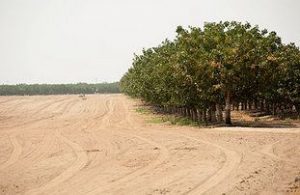Caring for Fruit Trees in the Dormant Season
Okay, I’ll go out on a limb: There is nothing so heavenly as a juicy, sugary peach picked ripe from your very own backyard tree in July. Sadly, there is nothing quite so heartbreaking as visiting that same tree one fine, summer morning, only to find the leaves sick and distorted by peach leaf curl.
UC Davis’ Integrated Pest Management program, which places a heavy emphasis on preventive measures, recommends that gardeners take a two-pronged approach to caring for fruit trees now. For existing trees, employ several dormant-season practices (below) that discourage or even kill spores, insect pests and/or eggs that overwinter on and around trees. For fruit trees you want to plant this fall, choose varieties that are more disease- and pest-resistant.
Whether you plan to add a new fruit tree or protect the ones you have, the following preventive practices in fall and winter can help ensure a healthy bounty next year.
One aspect of garden cleanup is proper pruning to remove diseased and dead branches. UC Davis’ webpage “The California Backyard Orchard” (homeorchard.ucdavis.edu) offers guidelines for pruning fruit trees, as well as a “Calendar of Backyard Gardening Operations” that provides a helpful to-do list for fruit tree management in every season.
Consider Dormant Oils. To prevent or stop the cycle of outbreaks, you can effectively smother one or more generations of insects with horticultural oil sprays. “Dormant sprays” can control a broad spectrum of soft-bodied insects such as aphids, mites and scales. The oil literally suffocates insects that are on the tree when sprayed, and can also prevent egg maturation. Unlike broad-spectrum pesticides, horticultural oils are much safer because they do not leave a long-term toxic residue that can harm beneficial insects.
There are also horticultural oils that contain an elemental chemical such as sulfur, lime sulfur or copper, which act as a fungicide and/or bactericide. Fixed copper products, for example, have long been used to fight the fungus that causes peach leaf curl in peaches and nectarines. The popular “Bordeaux mix,” which contains hydrated lime and copper sulfate, controls a wide range of diseases, such as fire blight, apple scab, brown rot, black spot, shot-hole disease, and more. These disease-preventing dormant oils must be used with care, though. They should only be applied on completely dormant fruit trees, on clear, windless days when the temperature is between 40 and 70 degrees, and when there is no chance of frost within 24 hours. Also know that if used in high concentrations over time, mineral dormant sprays can harm plants or damage soil organisms. Always follow the manufacturer’s instructions for use.
Choose Resistant Varieties. One of the best ways to minimize pest and disease outbreaks in fruit trees is to select varieties that are more resistant to attack. To research resistant fruit trees that do well in the foothills, contact the UCCE Master Gardeners of Tuolumne County office at (209)533-5912. Also visit the UC Davis Agricultural and Natural Resources website, which has exhaustive research and gardening advice, at www.ucanr.edu.
It’s a good thing that homegrown, freshly picked peach—or pear, cherry, plum—is so divine. It makes all of that year-round work worth the effort.
Rachel Oppedahl is a University of California Cooperative Extension Master Gardener of Tuolumne County.

